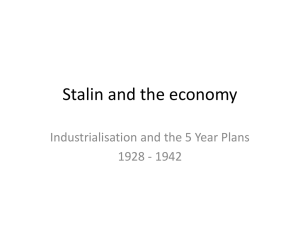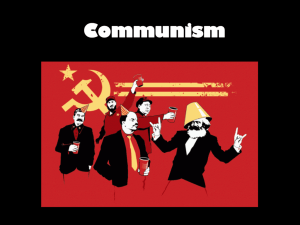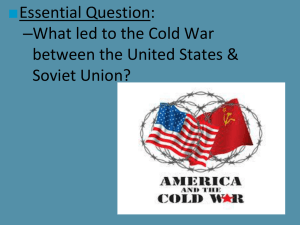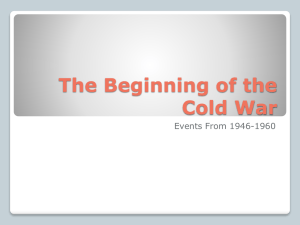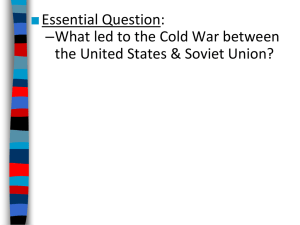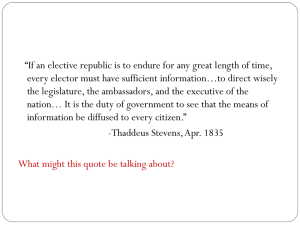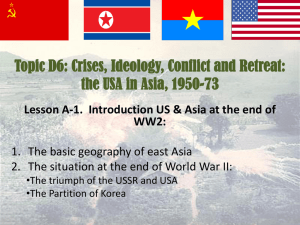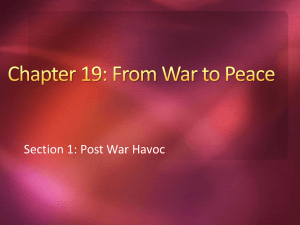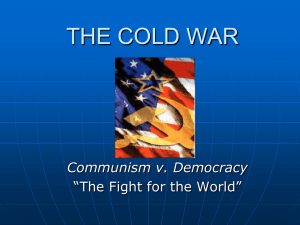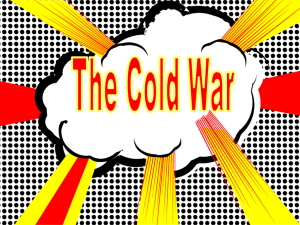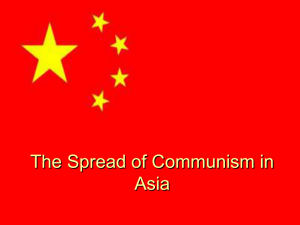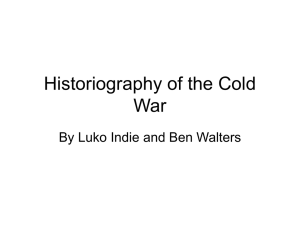What was the Cold War?
advertisement
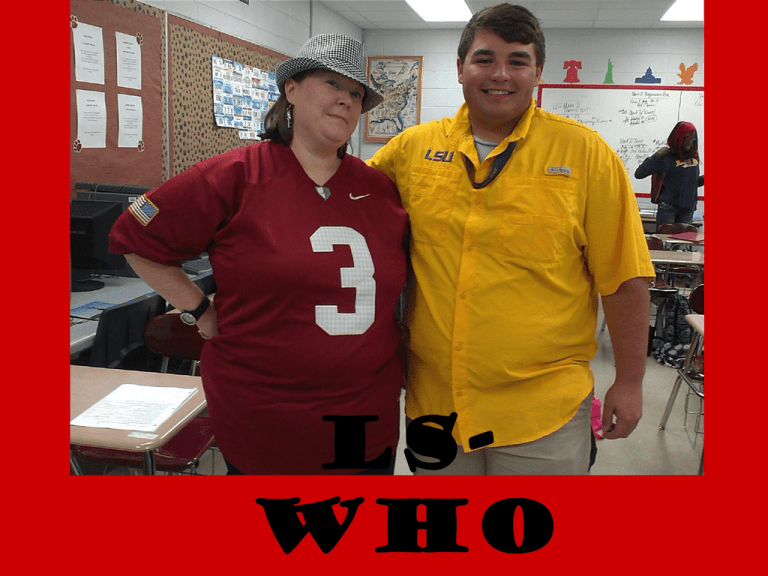
LSWHO ■Essential Question: –What led to the Cold War between the United States & the Soviet Union? ■Warm-Up Question: –Examine the image on the next slide & use it to answer this Q: –What was the Cold War? Use this image to search for clues What was the Cold War? The USA after World War II ■The end of WWII in 1945, marked a turning point in U.S. history by taking an active role in world affairs –The USA became a leader in the United Nations & World Bank –The U.S. occupied & helped rebuild Japan after the war –The U.S. helped found Israel as a Jewish nation in the Middle East United Nations Member Nations United Nations Headquarters is in New York City American Occupation of Japan The Cold War ■The most important change in U.S. foreign policy after WWII was the beginning of the Cold War –The Cold War was an era of distrust & hostility between the USA & USSR from 1945-1991 –It was an era of competing ideologies: The USA promoted democracy & capitalism while the USSR tried to spread communism Causes of the Cold War During The In the USA 1920s, WWII, sent After Lenin’s Vladimir Lenin troops Americans the fight & death into 1924, ledUSA the the USSR feared “Red worked Army” thein Joseph Stalin Bolsheviks together during spread the ofto became dictator the Russian Communism Russian defeat the Civil of the USSR Revolution in& Axis during War Powers, the started his 1917 “Red but... Scare” Five Year Plans Causes of the Cold War ■WWII increased hostilities between the USA & the USSR: –The U.S. & USSR emerged from the war as rival superpowers –The development of the atomic bomb gave the USA a monopoly on nuclear weapons But Stalin never did; Bybetween the time of the WWII hostilities USA &to USSR At increased the Yalta Conference, Stalin agreed Potsdam Conference, in Stalin began allow self-determination Eastern Europe extending his control over Eastern Europe Stalin refused to remove his military or allow free election in Eastern Europe As a result, Eastern European nations turned to Communism & became Soviet satellites—nations influenced by the USSR (the “Eastern bloc”) At the end of the war, Germany was divided into a zone occupied by the USSR (which became East Germany) & a zone occupied by the USA, Britain, & France (West Germany) The Iron Curtain Capitalism & Democracy Communism & Totalitarianism The USA began to view Stalin in the 1940s as a new Hitler—a dangerous dictator who wanted to take over the world In 1947, the U.S. began a policy of Containment to stop the spread of Communism by the USSR When the USSR began “A long-term, patient pressuring Greece & Turkey to but firm, and vigilant turn communist, the USA containment of Russian created the Truman Doctrine: expansionist U.S. economicpolicies… & military aid force towill anyeventually country threatened by the USSR to live in communism peace with the West” The—Secretary Truman Doctrine worked of State, & neither Greece nor Turkey George Marshall fell to communism In 1947, the U.S. began a policy of Containment to stop the spread of Communism by the USSR European nations had difficulty recovering after WWII which led to fears of communism in Europe The U.S. created the Marshall Plan: offered $13 billion to help rebuild post-war Europe By 1952, Western Europe recovered & Communism never took root Marshall Plan to Aid Europe 1948-1952 In 1947, the U.S. began a policy of Containment to stop the spread of Communism by the USSR In 1948, the USSR used military force to turn Czechoslovakia to communism; This led to fears that Stalin would use similar tactics in Western Europe In 1949, the USA formed the North Atlantic Treaty Organization (NATO): a military alliance among democratic countries NATO was one of many alliances the USA would form with democratic nations over the course of the Cold War NATO Communist Bloc The Berlin Blockade ■In 1948, the USSR responded to Containment by cutting off all traffic to Berlin in East Germany –The USA began the Berlin Airlift to bring food, fuel, & supplies to keep West Berlin from turning to Communism –The standoff lasted 2 weeks until Stalin lifted the blockade Reorganizing the Government The new air force was the preferred military ■By 1947, the U.S. gov’t created agency of the Cold War because airplanes3 new agencies during Cold War could drop nuclear bombsthe if needed –Dept of Defense to direct the Army & Navy; The military created the Air Force –Central Intelligence Agency to collect & manage information among all gov’t agencies –Nat’l Security Council to advise the president on nat’l security The Cold War Expands The Soviet atomic bombArms motivated the USA to The Nuclear Race regain its nuclear advantage; In 1952, the U.S. The U.S. monopoly on nuclear weapons st tested the 1 hydrogen bomb (1,000 times technology ended in 1949 when the USSR more powerful than the a-bomb) successfully tested their own atomic bomb The Soviets responded with their own hydrogen bomb in 1953 The Cold War in Asia ■Containment stopped communism in Europe, but by the late 1940s the Cold War spread to Asia: –Since the 1930s, Communist Mao Zedong fought democratic leaders for control of China –In 1949, Mao gained control & turned China to communism –Americans blamed President Truman for “losing China” Based upon this chart, why were Mao & the Communists so popular among the Chinese people? The Cold War in Asia ■America’s response to the fall of China was to more aggressively confront Communism in the world –The U.S. expanded the military & stockpiled nuclear weapons –The USA feared that China would influence its neighbors to turn communist (“domino theory”) –In 1950, the U.S. fought the Korean War to stop communism In 1950, North Korea crossed the 38° & attacked South Korea The USA led a United Nations intervention to stop North Korea But, when the USA pushed too close to ByChina, After 1953,WWII, a ceasefire Koreastopped was divided the fighting along the Chinese &the theentered 38° 38°with wasthe Communists restored in the boundary North Army war as the between &North democracy North the South Koreas & helped Korea&inSouth The USA stopped the spread of Communism into South Korea, but in 1954, Communist Ho Chi Minh began a war to gain independence for Vietnam Conclusions ■After World War II, U.S. foreign policy changed: –The U.S. became a superpower that actively intervened in world affairs –The Cold War increased military spending, nuclear weapons, & fears of a war with the USSR –President Truman successfully “contained” Communism in Europe but seemed to fail in Asia
